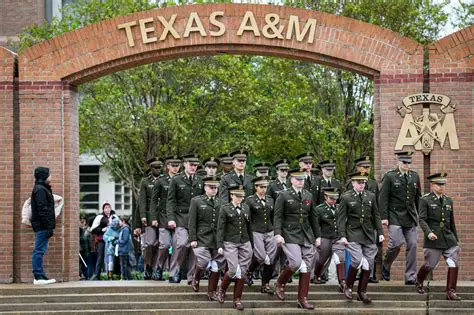Texas A&M University’s Army Reserve Officers’ Training Corps (ROTC) program is a renowned leadership development program that prepares students for a future in military service or civilian leadership roles. The program’s rigorous curriculum and extensive training opportunities help cadets develop physical, mental, and leadership skills essential for success in any field.

Mission and Goals of Texas A&M Army ROTC
The mission of Texas A&M Army ROTC is to produce leaders of character for the Army and the nation. The program seeks to develop cadets who are:
- Physically fit, mentally alert, and morally sound
- Committed to service and self-sacrifice
- Prepared for leadership roles in military or civilian careers
- Ready to meet the challenges of a rapidly changing world
Benefits of Joining Texas A&M Army ROTC
Joining Texas A&M Army ROTC offers numerous benefits to cadets, including:
- Scholarship opportunities: The program provides scholarships that cover tuition, fees, and living expenses for qualifying cadets.
- Leadership development: Cadets receive extensive leadership training and mentorship through classroom instruction, field exercises, and leadership positions.
- Physical fitness: The program promotes physical fitness and overall well-being through structured physical training and athletic competitions.
- Networking opportunities: Cadets have the opportunity to connect with military professionals, industry leaders, and future leaders.
- Guaranteed job placement: Upon graduation, cadets who complete the program are commissioned as second lieutenants in the U.S. Army.
Curriculum and Training
The Texas A&M Army ROTC curriculum is designed to provide cadets with a comprehensive understanding of military science, leadership, and related topics. The program consists of four years of study, including the following courses:
- Freshman (MS I): Introduction to Army ROTC, Military History, Leadership and Ethics
- Sophomore (MS II): Leadership Training, Military Geography, Land Navigation
- Junior (MS III): Tactics, Military Law, Leadership Management
- Senior (MS IV): Advanced Tactics, Staff Functions, Ethical Leadership
In addition to classroom instruction, cadets participate in weekly field training exercises that provide hands-on experience in leadership, problem-solving, and tactical operations. Cadets also have the opportunity to compete in intercollegiate sports, attend leadership conferences, and participate in various volunteer activities.
Opportunities for Advancement
Texas A&M Army ROTC offers a variety of opportunities for cadets to advance their leadership skills and career prospects. Cadets can compete for positions on the Ranger Challenge team, which participates in national competitions testing physical endurance, teamwork, and leadership ability. They can also pursue internships with military units or government agencies, gaining valuable experience in their chosen field.
Common Mistakes to Avoid
While Texas A&M Army ROTC is a challenging program, certain common mistakes can hinder a cadet’s success. These include:
- Lack of commitment: Cadets who fail to consistently attend training and participate fully in the program may fall behind and face difficulty meeting program requirements.
- Poor academic performance: Cadets must maintain a good academic standing to remain eligible for the program. Falling below the required GPA can lead to dismissal.
- Physical fitness deficiencies: Cadets are expected to meet rigorous physical fitness standards. Failure to meet these standards can result in additional training or even dismissal from the program.
Frequently Asked Questions
1. Is Texas A&M Army ROTC mandatory for all students?
No, participation in Texas A&M Army ROTC is voluntary. Students can choose to enroll in the program or pursue other interests.
2. What are the physical fitness requirements for cadets?
Cadets must meet Army physical fitness standards, including passing the Army Physical Fitness Test (APFT). The APFT consists of three events: push-ups, sit-ups, and a two-mile run.
3. Can ROTC cadets transfer to other universities?
Yes, cadets can transfer to other universities with Army ROTC programs. However, the transfer process may require the cadet to complete additional coursework or training.
4. What are the career prospects for ROTC graduates?
ROTC graduates have a variety of career options, including serving as commissioned officers in the U.S. Army, pursuing military or civilian careers in government agencies, or seeking employment in the private sector.
5. What is the difference between the four ROTC programs at Texas A&M?
Texas A&M University offers four Army ROTC programs:
- Corps of Cadets: A traditional four-year program with a focus on military leadership and discipline. Cadets live in a university-owned dormitory and participate in a rigorous training schedule.
- National Advanced Placement Program: A three-year program for students who have completed the first year of Army ROTC at another university. Candidates participate in summer training and receive scholarships.
- Simultaneous Membership Program: A two-year program for students who have already served in the military and meet certain eligibility criteria. Cadets attend classes as regular university students and participate in ROTC training.
- Military Science Minor: A non-commissioning program that allows students to take Army ROTC courses for academic credit without participating in the full program.
6. What is the process for applying to Texas A&M Army ROTC?
Interested students can apply to the program through the Texas A&M University Admissions Office. The application typically involves submitting transcripts, letters of recommendation, and an essay. Cadets must also meet minimum physical fitness and GPA requirements.
